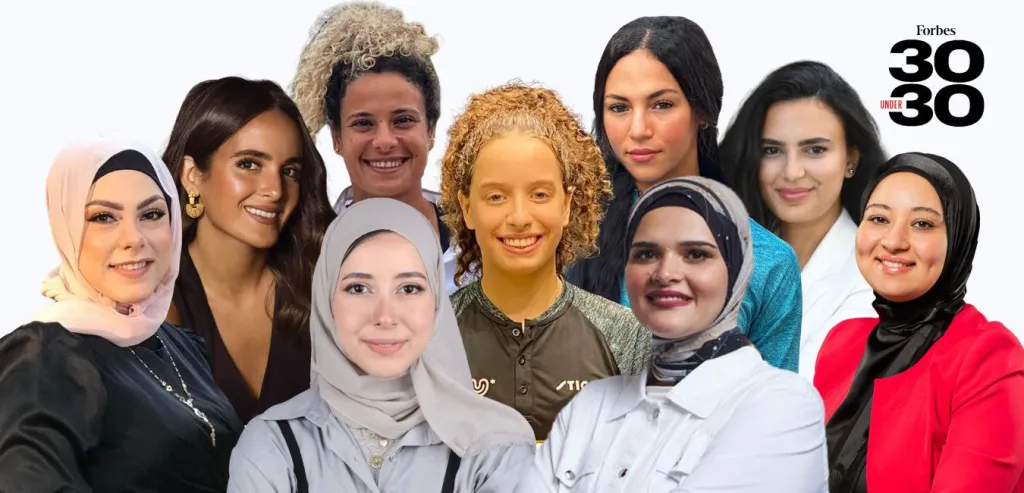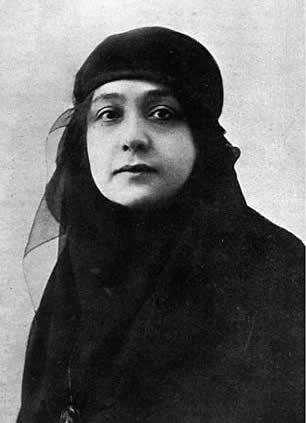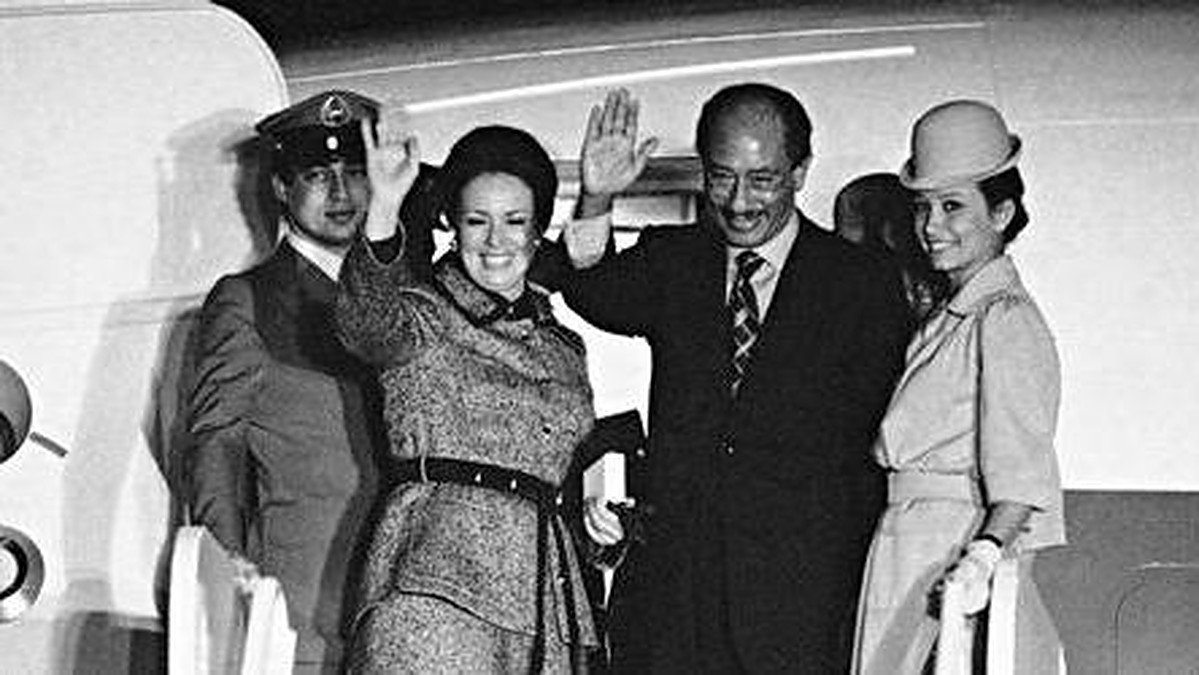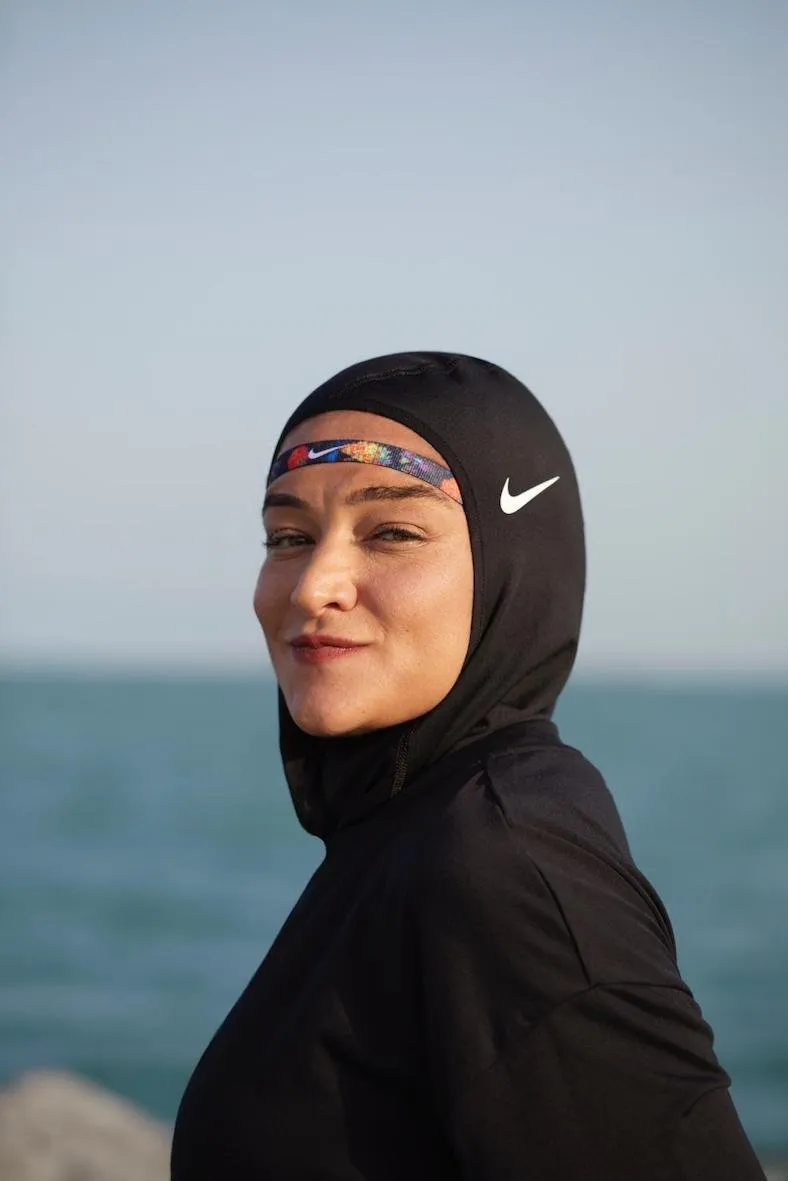
Nine Egyptian Women on 2023 Forbes Middle East’s 30 Under 30 List [Women of Egypt (November 25, 2023)]
By Amira Fekry
This article is part of the Gender, Sexuality, and Decolonization Resource Page blog.

Nine Egyptian Women on 2023 Forbes Middle East’s 30 Under 30 List [Women of Egypt (November 25, 2023)]
I always felt that my family was very different. On weekends, we'd visit my dad's side, who were rich and lived in a fancy part of Cairo. But on holidays, we'd go to my mom's side, who lived in a simpler neighborhood in Alexandria. To tell you the truth, I always felt out of place with my dad's family. They thought I was too conservative and old-fashioned. They wanted me to dress in a more “flattering” way and act more modern, but I didn't know how. When I was 19, I decided to wear a hijab. My cousins were upset. One even said she didn't want to be seen with me in public because I looked unattractive and aged.
This, today, resonates with my immense identity crisis. As a modern Egyptian woman, I often feel misplaced in cultural categories, unable to find a clear identity that accurately reflects my religious and cultural background. I was always especially furious at the fact that I can never attend a regional or global work event dressed as an Egyptian because I did not know the answer to a seemingly simple question: What does an Egyptian woman look like?
This question may appear innocent, yet it demonstrates a deeper issue: the tendency to reduce people to their appearance. Existing research on Egyptian women's identity demonstrates how this question, particularly when focused on dress choices such as the veil, can perpetuate damaging stereotypes and obscure the wide diversity of experiences and identities among Egyptian women.[1] The historical contradiction between the "modern, unveiled" and the "traditional, veiled" woman is an oversimplification that ignores the intricacies of individual agency, as well as societal and political influences.[2] Instead of focusing on appearances, we should investigate the historical, social, and political factors that have influenced Egyptian women's lives and decisions. These forces include colonialism, which influenced perceptions of Egyptian women through an Orientalist lens;[3] nationalism, which frequently promoted specific visions of the "modern" Egyptian woman, sometimes aligned with Western ideals,[4] and sometimes emphasizing traditional values;[5] and feminism, which encompasses diverse voices and perspectives, including those who advocated for unveiling and those who embraced alternative models of empowerment.[6] Furthermore, the Islamic renaissance of the 1970s and the emergence of consumer culture, notably fashion, have added new layers to the debate over Egyptian women's attire and identity. Understanding these complicated and interwoven aspects allows us to move beyond superficial assessments of appearance and interact with the deep realities of Egyptian women's lives.[7]
Colonial Legacies and National Pride: A Tug-of-War
The lingering legacies of colonialism (14th-19th centuries), and nationalism (late 19th century), have molded Egyptian women's identities. Ottoman (1517-1798), French (1798-1801), and English (1882-1956) colonial regimes frequently imposed rigid gender roles, while nationalist organizations also used traditional values to create an "authentic" Egyptian identity.[8]
Existing literature emphasizes how the colonial collision, particularly with British and French forces, influenced ideas of Egyptian women and their clothes.[9] Colonial administrators and writers saw customs such as veiling through an Orientalist lens, viewing Eastern cultures, such as veiling, through a framework of Western superiority and misrepresentation, presenting them as emblems of tyranny and backwardness.[10] This basic viewpoint undermines the agency of women who choose to veil for a variety of reasons, such as religious commitment, cultural identification, or even resistance to Western cultural hegemony.[11] The term "veiling" as used in Western publications is frequently a misnomer, as it refers to a vast range of head coverings with distinct meanings and cultural implications.[12] This colonial ideology frequently ignored the actual autonomy and rights of both European and colonized women, exposing the irony of citing "liberation" as an excuse for cultural imposition.[13]
On the sociopolitical front, colonial rulings of Egypt have widened disparities between the wealthy elite and the destitute masses, fueling societal tensions. Western dress was associated with modernity and the upper classes, while traditional Egyptian clothing was seen as a sign of backwardness and lower social status,[14] further disenfranchising many Egyptians in the favor of foreign interests and the interests of a small privileged class. The rise of intellectual movements, particularly the establishment of a modern Egyptian press and the emergence of nationalist philosophers and authors, were critical in molding national consciousness. These intellectuals highlighted Egyptians' problems and advocated for greater autonomy and self-determination.
The rise of nationalism in Egypt in the late 19th century exacerbated the issue of women's looks and clothes.[15] Nationalist organizations struggled with the influence of Western culture as they sought to create an "authentic" Egyptian identity. While some nationalists admired Western progressive values and equated them with unveiling, others saw European clothing patterns as an affront on cultural identity.
Huda Shaarawi, a well-known Egyptian feminist, managed these conflicts by questioning both patriarchal structures in Egypt and Western perceptions of Muslim women.[16] Shaarawi aimed to dispel the Western misconception of Egyptian Muslim women as uneducated and primitive. She argued that veiling did not prevent women from pursuing education and challenged the notion that it was the root cause of their oppression. Instead, she believed that societal traditions and customs confined women to the domestic sphere. Shaarawi stressed the importance of women's autonomy in choosing their attire and recognized the Western misinterpretation of veiling as a symbol of oppression.[17]

Huda Sharawi [Source: Wikipedia (August, 2024)]
Fashioning the Nation: Style and Identity in Post-Colonial Egypt
In 1952, Egyptian rule was re-established following a long period of foreign influence, giving more power to local voices to determine their realities. A new generation of Egyptian women has embraced fashion as a tool for self-expression and empowerment in the public and private spheres. Salem's research on women's movements under Nasser (1954-1970) and Sadat (1970-1981)[18] demonstrate how Egyptian women used their voices and bodies as political tools to oppose both Western imperialism and local tyranny.[19]
Socialist Chic: Fashion and Identity in Nasser's Egypt
Nasser's leadership in Egypt sought to modernize the country, foster a distinct Egyptian identity, and minimize foreign influence, all of which had a considerable impact on women's fashion. While encouraging women's participation in public life and promoting a more "authentically Egyptian" style, the government also discouraged consumerism and may have constrained individual expression through official control. Interestingly, the class divide continued into the Nasser era where Western fashion became associated with modernity and government officials, despite the government's aim to reduce social inequality.[20]
The 1970s Islamic Fashion: A New Era
The Islamic revival of the 1970s under Sadat’s regime marked another fashion shift, moving beyond the simple act of reviving pre-colonial attire.[21] This new fashion era included a sleek, contemporary look that combined Western accents with Islamic modesty. Long-sleeved blouses, flowing skirts, long dresses, and fashionable headscarves became the norm. This shift went hand-in-hand with Sadat’s “open door” policy (1974), which fostered capitalism, promoting international investment and private enterprise.[22]
The "open door" policy introduced consumerism and had a significant impact on how women exhibited their beliefs and style. Now that fashionable head scarves were becoming a status symbol, the once-modest hijab had to adapt to the demands of fashion. This consumerist trend had a big impact on self-perceptions and beauty standards. Class also played a major role in this societal entrenchment where clothing became a marker of wealth and social mobility, alongside a resurgence of Islamic dress among various classes, with wealthy women displaying their status through expensive fabrics.[23]
While the Sadat regime appeared to advance women's empowerment, criticism suggests a “gender washing” strategy, employing manipulative tactics, including favorable policies and the active role of the First Lady to project a liberal image and deflect criticism. This seemingly progressive approach served to reinforce existing patriarchal structures within Egypt, rather than leading to substantial improvements in women's rights.[24]

Anwar and Gihan El Sadat [Sayed, Mirna Khaled (2021). Good Wife or Public Wife? The Evolving Role of Egypt’s First Ladies. Egyptian Streets]
In the end, there was no one-size-fits-all result from the Islamic renaissance. It promoted a variety of perspectives regarding Islamic customs and women's attire. Some people donned the veil for personal reasons; in a conservative social milieu, veiling can give women a sense of security and dignity, allowing them to engage in public life without fear of unwanted attention or harassment. Others saw it as a sign of resistance against both local and Western conservative and patriarchal influences.[25]
A Glimpse into the Modern Era
In today’s spheres in Egypt, the classic abaya, modified by young designers, is worn with bright head scarves or casual Western apparel, combining styles that revere tradition with those that embrace global trends. Influencers on Instagram and other platforms highlight women's freedom to express their diverse identities through various styles. The hijab has become integrated into fashion trends, with diverse meanings and styles that express personal faith, cultural identity, and social expectations, while class distinctions are still visible through fashion choices and access to high-end brands.[26]

[Hasan, Mahdy (September 2022). “Egyptian Fashion Market”. LinkedIn]

[Lemailloteg, Instagram]
In the same line, media and online platforms have been enabling young Egyptian women to reclaim narratives, particularly those concerning body image and beauty standards. There is a visible backlash against Eurocentric beauty ideals, with women celebrating darker complexion tones, natural hair, and traditional clothes. This movement, which has been disseminated through hashtags, TikTok videos, and community debates, demonstrates how Egyptian women are actively altering beauty and identity standards.
A core example of this is the unsettled debate that sparked around Sawsan Badr in 2023. By embracing her natural look, especially her silver hair, Egyptian actress Sawsan Badr also questions traditional standards of beauty in a modern setting. This strategy of “protesting beauty standards based on hair color, skin color, and age and embracing one’s true self” resonates with how Muslim women decide to wear a headscarf to express their true identities and challenge "Orientalist" views.[27]

[El Mokadem, Mai (April 18, 2024). Styled Archives: Sawsan Badr’s Best Moments. Scene Styled]
Similarly, Manal Rostom, an Egyptian marathon runner and mountaineer, promotes a "stylish hijab" on social media and collaborates with brands such as Nike, exemplifying how women are embracing fashion to break down barriers and redefine expectations.[28]

Manal Rostom [Speakers buzz]
Conclusion
The contemporary perception of Egyptian women is nuanced and multidimensional. From the nationalist quest for unification to the present feminist emphasis on individual rights, identity is a combination of internal ideals and external forces. Examining this dynamic and evolving identity provides insight not only into Egyptian women, but also into the larger sociopolitical factors shaping how gender, culture, and nationalism intersect in the modern world.
It’s more fruitful to recognize the diverse range of styles and options available to Egyptian women today rather than attempting to find a single, conclusive solution. Let's embrace Egyptian women's uniqueness and honor their many manifestations of beauty and style as we continue to negotiate the intricate terrain of identity and fashion.
The issue of whether or not to wear veils is only one part of a bigger picture. We ought to ask ourselves instead: How can I dress in a way that gives me confidence and comfort? Beyond fashion, what additional forms of expression are there for my Egyptian heritage and identity?
Amira Fekry is a trilingual Egyptian development practitioner. With +8 years of experience, Amira specializes in initiatives aimed at youth and women’s economic empowerment through systems change in underserved regions across Egypt, the MENA region and Africa. Amira holds a BA in Political Science from Cairo University and an MA in Public Policy from the AUC and the IHEID.
[1] Abdelrazek-Alsiefy, Amany. 2023. Modern Egyptian Women, Fashion and Faith: Discourses and Representations. Cham: Springer Nature Switzerland AG. 3-7
[2] Salem, Sara. 2017. "Four Women of Egypt: Memory, Geopolitics, and the Egyptian Women’s Movement during the Nasser and Sadat Eras." Hypatia 32 (3): 593–608.
[3] Abdelrazek-Alsiefy, op. cit.; Anarfi Gordon, Ruth Frimpomaa. 2021. "The Evolution of Colonial Legacy and Social Status of Women, a Case Study of Egypt between 1952-2016." PEOPLE: International Journal of Social Sciences 7 (3): 59–81; Galián, Laura. 2020. "Decolonising sexuality in Egypt: al-Tatawwur’s struggle for liberation." Postcolonial Studies. https://doi.org/10.1080/13688790.2020.1762289; Lisiecka, Julia. 2015. "Re-Reading Huda Shaarawi's 'Harem Years'–Bargaining with the Patriarchy in the Changing Egypt." The SOAS Journal of Postgraduate Research 8: 46-58.
[4] Abdelrazek-Alsiefy, op. cit.; Aly, Menat. 2023. "Gender Washing Autocracies in Egypt: Drawing on the Presidency’s Of Anwar El Sadat and Hosni Mubarak." Master's thesis, American University in Cairo.
[5] Abdelrazek-Alsiefy, op. cit.
[6] Abdelrazek-Alsiefy, op. cit.; Lisiecka, op. cit.
[7] Abdelrazek-Alsiefy, op. cit.
[8] BBC (7 January, 2019). Egypt profile - Timeline. Accessed on: https://www.bbc.com/news/world-africa-13315719.
[9] Elia, Nada (25 March, 2024). “Bodies of land: feminism and decolonisation.” The Architectural Review; Gordon. A. F. R. & Zhang, Q. (2021). The Evolution of Colonial Legacy and Social Status of Women, A Case Study of Egypt between 1952-2016. PEOPLE: International Journal of Social Sciences, 7(3), 59-81.
[10] Beck, Elizabeth and Wahab, Stéphanie (March 2015). Orientalism, Oppression, and Contemporary Social Work. International Encyclopedia of the Social & Behavioral Sciences (Second Edition). 428-434. Accessed on: https://doi.org/10.1016/B978-0-08-097086-8.28066-5.
[11] Abdelrazek-Alsiefy, op. cit.; Lisiecka, op. cit.
[12] Abdelrazek-Alsiefy, op. cit.
[13] Elia, op. cit., 2
[14] Abdelrazek-Alsiefy, op. cit.; Lisiecka, op. cit.
[15] Aly, op. cit.,
[16] Abdelrazek-Alsiefy, op. cit.; Gordon, op. cit.; Galián, op. Cit.; Lisiecka, op. cit.; Salem, Sara. 2019. "Trajectories of Anticolonialism in Egypt." E-International Relations (blog). April 3, 2019. https://www.e-ir.info/2019/04/03/trajectories-of-anticolonialism-in-egypt/.
[17] Lisiecka, op. cit.; Abdelrazek-Alsiefy, op. cit.
[18] BBC (7 January, 2019). Egypt profile - Timeline. Accessed on: https://www.bbc.com/news/world-africa-13315719.
[19] Salem (2017), op. cit.
[20] Salem (2019), op. cit.; Salem (2017), op. cit.
[21] Abdelrazek-Alsiefy, op. cit.; Salem (2017), op. cit.
[22] Ibid.
[23] Abdelrazek-Alsiefy, op. cit.; Aly, op. cit.
[24] Aly, op. cit.
[25] Abdelrazek-Alsiefy, op. cit.
[26] Abdelrazek-Alsiefy, op. cit.
[27] Kelly, Elizabeth (September 8, 2023). Egyptian Actress Sawsan Badr Defying Outdated Beauty Norms And Redefining Ageism. Harper’s Bazaar Arabia.
[28] Abdelrazek-Alsiefy, op. cit.